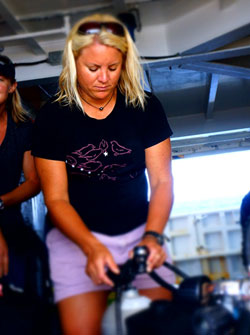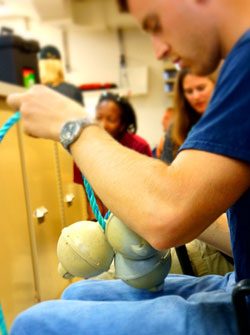2012 Maritime Heritage Expedition Log by Etta Karth – July 6, 2012
Safety drills and training
At 8:30 AM boat drills commence – we need to know where to go and what to do in the event of a fire, abandon ship or a man overboard. The vessel is huge and if you don't know your way about, it could be very dangerous in an emergency situation.
Every person on the boat has assigned areas to meet if there is a crisis situation. There areP too many of us to meet all in the same location. The first drill – abandon ship; each individual on the boat has, in their compact room, an emergency ocean immersion suit and life vest. They are a bit difficult to get yourself inside of, and make you look like Gumby, but save lives.
Gear checks and small boat emergency overviews follow the drills. Divers need to be sure everything is up to par and functioning properly and primed for any emergency on the small boats before dive ops.

Kelly Gleason (PMNM Maritime Heritage Lead Scientist) checks to make sure her dive gear is functioning properly. Credit: Etta Karth/NOAA

Mark Royer (HIMB Graduate student; Top Predator Movements in the NWHI) makes new acoustic reciever mooring lines to be placed within PMNM. Others in photo: Sherril Leon Soon (left), HIMB Oceanography, and Jackie Troller (right), HIMB Coral Disease Surveys. Credit: Etta Karth/NOAA
People Feature – Mark Royer
Title: Graduate Student at HIMB, working on apex predator tracking under Carl Meyer
Project on Hiʻialakai: Movements of Reef Predators in the NWHI
Project Summary: Deploying and retrieving of VR2W Acoustic Receivers, making new mooring lines with attached buoys for new receivers, downloading data from retrieved receivers, tagging Tiger and Galapagos sharks.
Significance of study: Ecology and management of marine top predators: Movement patterns and habitat use of top predators; Influence of physical oceanography on top predator movements; Trophic ecology of top predators; Ecological impact of shark ecotourism. Effectiveness of Marine Protected Areas: Movement patterns and habitat use of reef fishes in MPAs, Role of habitat geography in MPA boundary porosity, Impacts of human recreational activities in MPAs. Navigational abilities of sharks: Magnetic sense; Cognitive maps.
How he got to where he is today: Mark has always had an interest in sharks since a very young age - he knew they were important creatures to coral reef and oceanic ecosystems world wide, and as he learned more, knew there was a need for shark conservation. Soon before beginning college, he took a SCUBA trip to Rangiroa in French Polynesia where he got to experience what a fairly healthy coral reef ecosystem looks like (high apex predator populations). He went to school at the University of North Carolina Wilmington for Marine Biology. His sophomore year, he was granted an internship with Scripps working with Andy Nosal, assisting with the tagging and tracking of Leopard Sharks in San Diego, CA. This was Marks first hands on research experience with these magnificent creatures. He began looking at Grad Schools with Apex predator studies, and was accepted by Dr. Carl Meyer and Dr. Kim Holland for a Masters degree as a research assistant. When he got to Hawaiʻi, he "got thrown into the deep end and had to learn very quickly". On the Hiʻialakai Mark continues to assist with the NWHI Top Predator Movements in the NWHI project.
